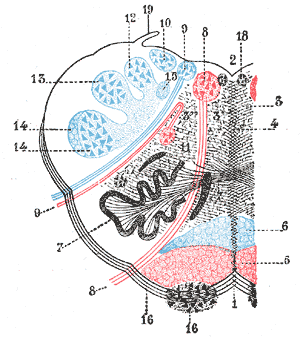Parvocellular reticular nucleus
Parvocellular Reticular Nucleus[edit | edit source]
The Parvocellular Reticular Nucleus (PRN) is a component of the brainstem that plays a significant role in the regulation of motor control. It is part of the reticular formation, a set of interconnected nuclei that are located throughout the brainstem.
Structure[edit | edit source]
The Parvocellular Reticular Nucleus is located in the medulla oblongata, the lower half of the brainstem. It is situated close to the midline, adjacent to the paramedian reticular nucleus. The PRN is characterized by its small, densely packed cells, from which it derives its name - 'parvocellular' means 'small cell'.
Function[edit | edit source]
The PRN is involved in the control of eye movement and gaze. It receives input from the superior colliculus, a structure in the midbrain that processes visual information. The PRN also sends projections to the spinal cord, influencing motor control.
Clinical Significance[edit | edit source]
Damage to the PRN can result in a range of motor control disorders, including ataxia and dysmetria. It may also contribute to the development of certain neurodegenerative diseases, such as Parkinson's disease.
See Also[edit | edit source]
References[edit | edit source]
Search WikiMD
Ad.Tired of being Overweight? Try W8MD's physician weight loss program.
Semaglutide (Ozempic / Wegovy and Tirzepatide (Mounjaro / Zepbound) available.
Advertise on WikiMD
|
WikiMD's Wellness Encyclopedia |
| Let Food Be Thy Medicine Medicine Thy Food - Hippocrates |
Translate this page: - East Asian
中文,
日本,
한국어,
South Asian
हिन्दी,
தமிழ்,
తెలుగు,
Urdu,
ಕನ್ನಡ,
Southeast Asian
Indonesian,
Vietnamese,
Thai,
မြန်မာဘာသာ,
বাংলা
European
español,
Deutsch,
français,
Greek,
português do Brasil,
polski,
română,
русский,
Nederlands,
norsk,
svenska,
suomi,
Italian
Middle Eastern & African
عربى,
Turkish,
Persian,
Hebrew,
Afrikaans,
isiZulu,
Kiswahili,
Other
Bulgarian,
Hungarian,
Czech,
Swedish,
മലയാളം,
मराठी,
ਪੰਜਾਬੀ,
ગુજરાતી,
Portuguese,
Ukrainian
Medical Disclaimer: WikiMD is not a substitute for professional medical advice. The information on WikiMD is provided as an information resource only, may be incorrect, outdated or misleading, and is not to be used or relied on for any diagnostic or treatment purposes. Please consult your health care provider before making any healthcare decisions or for guidance about a specific medical condition. WikiMD expressly disclaims responsibility, and shall have no liability, for any damages, loss, injury, or liability whatsoever suffered as a result of your reliance on the information contained in this site. By visiting this site you agree to the foregoing terms and conditions, which may from time to time be changed or supplemented by WikiMD. If you do not agree to the foregoing terms and conditions, you should not enter or use this site. See full disclaimer.
Credits:Most images are courtesy of Wikimedia commons, and templates, categories Wikipedia, licensed under CC BY SA or similar.
Contributors: Prab R. Tumpati, MD

